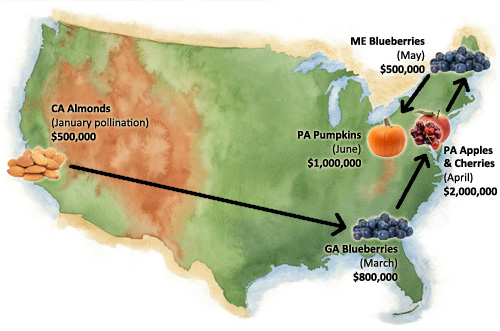10
Feb
Oral Arguments Presented in Landmark Organic Lawsuit against Monsanto
(Beyond Pesticides, February 10, 2012) Federal District Court Judge Nancy Buchwald heard oral arguments on January 31 on a pre-trial motion filed by Monsanto to dismiss a lawsuit filed against it by the Public Patent Foundation (PUBPAT) on behalf of family farmers, seed businesses, organic agricultural organizations, and environmental groups. The case, Organic Seed Growers & Trade Association, et al. v. Monsanto, challenges Monsantoâs patents on genetically modified seed. The suit was originally filed on behalf of 60 plaintiffs on March 29, 2011, with 23 new plaintiffs, including Beyond Pesticides joining on June 1. The 83 plaintiffs now involved in the suit represent a combined membership in excess of 300,000 people.
The plaintiffs in this case are suing preemptively to protect themselves from being accused of patent infringement should they ever become contaminated by Monsantoâs genetically engineered seed, something Monsanto has done to others in the past. âWe were very pleased that the court granted our request to have oral argument regarding Monsanto’s motion to dismiss our case today,” said Daniel Ravicher, PUBPAT Executive Director and lead lawyer for the plaintiffs. “The judge graciously permitted both parties to raise all the points they wished in a session that lasted over an hour. While Monsanto’s attorney attempted to portray the risk organic farmers face from being contaminated and then accused of patent infringement as hypothetical and abstract, we rebutted those arguments with the concrete proof of the harm being suffered by our clients in their attempts to avoid such accusations.â Hundreds of organic farmers and advocates engaged in a dynamic Citizenâs Rally organized by several groups including Occupy Food Justice that was held outside the court house after the hearing.
Genetic contamination of organic and non-genetically engineered crops by pollen that originates from genetically engineered crops and drifts to neighboring field has been incontrovertibly confirmed by scientific research. It is especially prevalent with the wind-pollinated corn and insect-pollinated canola, whose pollen can travel for two or more miles before fertilizing another plant. Such contamination has proven extremely costly to farmers raising organic and non-genetically engineered crops whose loads are rejected by buyers when trace levels of contamination are detected. Farmers in these circumstances lose any potential price premium for the extra effort and expense taken to preserve their cropâs integrity and they typically have no recourse but to dump the load on generic markets. Under the current interpretation of relevant law, Monsanto bears no legal or financial responsibility for such contamination.
The crux of the Federal District Court case is Monsantoâs claim that it has the right to sue farmers whose crops are contaminated for infringing upon the companyâs intellectual property. The intellectual property Monsanto is referring to is the patented genetic material in the drifting pollen that is ultimately expressed in the contaminated organic or non-genetically engineered crop. âI donât think itâs fair that Monsanto should be able to sue my family for patent infringement because their transgenic seed trespasses onto our farm and contaminates and ruins our organic crop. We have had to abandon raising corn because we are afraid Monsanto wouldnât control their genetic pollution and then they would come after us for patent infringement. Itâs not right,â said organic farmer Bryce Stephens of Jennings, Kansas and OSGATA member
PUBPAT is asking Judge Buchwald to declare that if organic farmers are ever contaminated by Monsantoâs genetically modified seed, they need not fear also being accused of patent infringement. To support this position, PUBPAT argues that Monsantoâs patents on genetically modified seed are invalid because they donât meet the âusefulnessâ requirement of patent law, according to Mr. Ravicher. Evidence cited by PUBPAT proves that genetically modified seed has negative economic and health effects, while the promised benefits of genetically modified seed â increased production and decreased herbicide use â are false. Beyond Pesticides regularly updates its website with resources documenting the risks of genetic engineering and information on public advocacy actions and campaigns to restrict or eliminate their use.
Soon after the original filing of the lawsuit, Monsanto issued a statement saying it would not assert its patents against farmers who suffer âtraceâ amounts of transgenic contamination. In response, and in the hope that the matter could be resolved out of court, PUBPAT attorneys wrote Monsantoâs attorneys asking the company to make its promise legally binding. The lawyers rejected PUBPATâs request and instead confirmed that the company may indeed make claims of patent infringement against organic farmers who become contaminated by Monsantoâs genetically modified seed. Copies of both letters are available as exhibits at the end of the amended complaint.
Beyond Pesticides is also a plaintiff in another lawsuit involving genetically engineered crops led by attorneys for the Center for Food Safety (CFS), Earthjustice, and farm and environmental groups. The lawsuit filed against the U.S. Department of Agriculture (USDA) argues that the agencyâs 2011 unrestricted approval of genetically engineered alfalfa is unlawful.
Source: Organic seed Growers and Trade Association press release
All unattributed positions and opinions in this piece are those of Beyond Pesticides.















 (Beyond Pesticides, January 10, 2012) A Purdue University study shows that honey beesâ exposure to the highly toxic neonicotinoid pesticide
(Beyond Pesticides, January 10, 2012) A Purdue University study shows that honey beesâ exposure to the highly toxic neonicotinoid pesticide 
